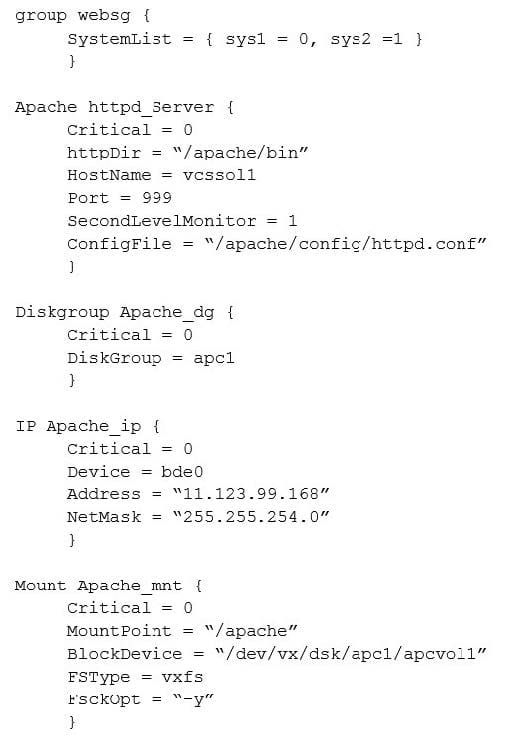Exam Details
Exam Code
:VCS-256Exam Name
:Administration of Veritas InfoScale Availability 7.1 for UNIX/LinuxCertification
:Veritas CertificationsVendor
:VeritasTotal Questions
:84 Q&AsLast Updated
:Jun 27, 2025
Veritas Veritas Certifications VCS-256 Questions & Answers
-
Question 1:
A database administrator needs to work on a database protected by a service group named DatabaseSG1, and plans to stop and restart the database several times throughout the day. Which command should the cluster administrator use to accommodate the database administrator?
A. hagrp –freeze DatabaseSG1
B. hagrp –modify DatabaseSG1 Active=0
C. hagrp –freeze –all -force
D. haclus –modify DatabaseSG1 Enable=0
-
Question 2:
Which two resource attributes must the administrator set correctly to prevent an outage when a new resource is brought online? (Select two.)
A. AutoDisabled
B. Critical
C. Enabled
D. Frozen
E. MonitorOnly
-
Question 3:
What is the purpose of the Statistics cluster attribute?
A. to collect metering data for supporting AdaptiveHA
B. to provide performance measurements to VIOM
C. to calculate availability and downtime levels
D. to calculate system and network resource usage
-
Question 4:
How is the Authority attribute of a global service group used?
A. to authorize the users who have administrative privileges over the global service group
B. to authorize the cluster on which all administrative actions should be performed for the global service group
C. to give authority for automated failover of the global service group across remote clusters
D. to specify the right to attempt bringing the global service group online in the cluster
-
Question 5:
An administrator manually edits the Veritas Cluster Server configuration file while a cluster is stopped. When the cluster is restarted, all the changes made are missing. Why are the changes made to the configuration file missing?
A. The cluster was started first on the node where the changes were made.
B. The haconf –save command needs to be run after making the manual changes.
C. The cluster was started first on a node other than the one where the changes were made.
D. The haconf –dump command needs to be run prior to starting the cluster.
-
Question 6:
Which two characteristics represent a Veritas Cluster Server (VCS) resource? (Select two.)
A. A VCS resource corresponds to a hardware or software component.
B. A VCS resource allows cyclical dependencies without a clear starting point.
C. A VCS resource allows only persistent resources to be a parent.
D. A VCS resource has a unique name throughout the cluster.
E. A VCS resource has a single entry point that the agent uses to control the resource.
-
Question 7:
An administrator is bringing a service group online. One of the resources is remaining offline, and is shown in waiting to go online state. Which command should the administrator run to stop Veritas Cluster Server from attempting to bring the resource online to troubleshoot the issue?
A. hares -clear
B. hares -offline
C. hagrp -offline
D. hagrp -flush
-
Question 8:
What are two effects of a failed resource in the service group configuration below? (Select two.)

A. Any resource fault leads to a faulted state for the resource.
B. Any resource fault leads to the service group failing over.
C. Any resource fault leads to the service group being taken offline.
D. Any resource fault leaves the service group partially online.
E. Any resource fault leaves the service group fully online.
-
Question 9:
What does the AdaptiveHA feature of Veritas Cluster Server (VCS) provide?
A. It uses the Priority attribute of service groups to take lower priority service groups offline when a higher priority service group fails over to the system.
B. It selects the biggest available target system to fail over an application when the service group attribute FailOverPolicy is set to BiggestAvailable.
C. It switches a service group with FailOverPolicy set to BiggestAvailable to less loaded systems in the cluster when the local system becomes overloaded.
D. It provides increased availability to the applications on the single node VCS cluster in virtual environments for planned maintenance events.
-
Question 10:
A cluster has two high-priority LLT links and one low-priority link. The low-priority link is used for public network traffic. What is the state of the cluster if both high-priority links fail simultaneously?
A. All nodes remain in regular GAB membership, but are also in jeopardy membership.
B. The cluster is in a split-brain condition until at least one other LLT link is working.
C. The fencing race is initiated and service groups are failed over the winning nodes.
D. Service groups are unable to failover when resource faults occur, but can failover if a system fault occurs.
Related Exams:
VCS-256
Administration of Veritas InfoScale Availability 7.1 for UNIX/LinuxVCS-257
Administration of Veritas InfoScale Storage 7.1 for UNIX/LinuxVCS-260
Administration of Veritas InfoScale Availability 7.3 for UNIX/LinuxVCS-261
Administration of Veritas InfoScale Storage 7.3 for UNIX/LinuxVCS-275
Administration of Veritas NetBackup 7.7 and NetBackup Appliances 2.7VCS-276
Administration of Veritas NetBackup 8.0VCS-277
Administration of Veritas NetBackup 8.0 and NetBackup Appliances 3.0VCS-278
Administration of Veritas NetBackup 8.1.2VCS-279
Administration of Veritas NetBackup 8.1.2 and NetBackup Appliances 3.1.2VCS-285
Veritas NetBackup 10.x and NetBackup Appliance 5.x Administrator
Tips on How to Prepare for the Exams
Nowadays, the certification exams become more and more important and required by more and more enterprises when applying for a job. But how to prepare for the exam effectively? How to prepare for the exam in a short time with less efforts? How to get a ideal result and how to find the most reliable resources? Here on Vcedump.com, you will find all the answers. Vcedump.com provide not only Veritas exam questions, answers and explanations but also complete assistance on your exam preparation and certification application. If you are confused on your VCS-256 exam preparations and Veritas certification application, do not hesitate to visit our Vcedump.com to find your solutions here.